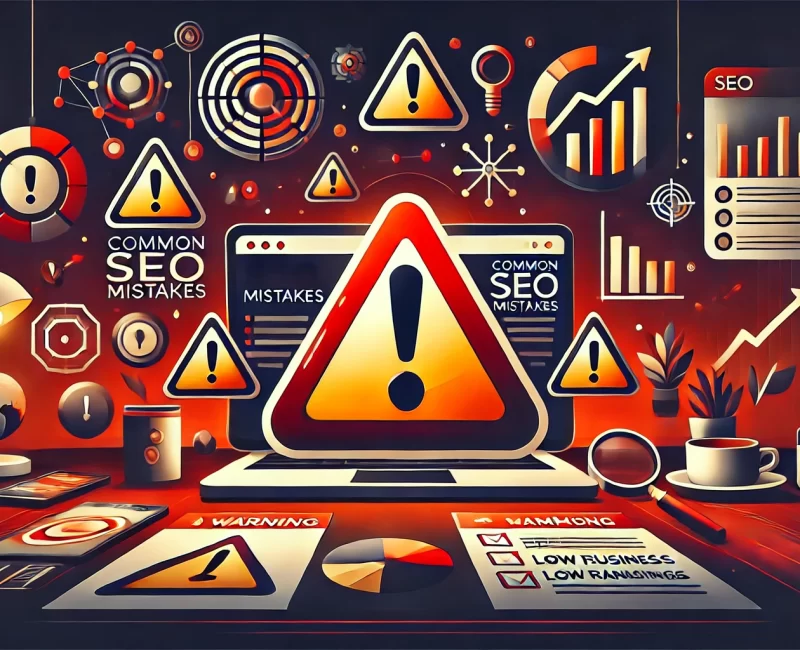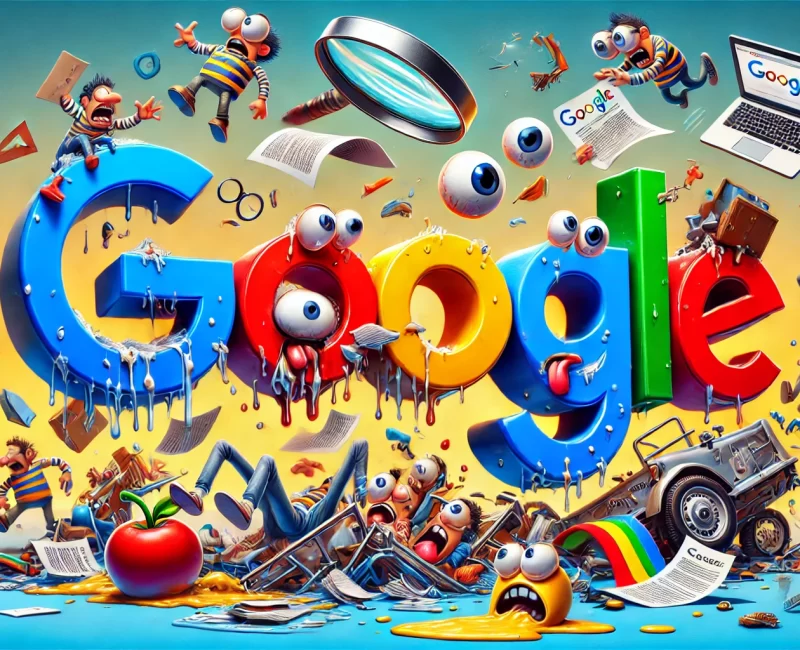
What Is SEO?
SEO is an abbreviation for “search engine optimization.”
It is, as the name implies, the process of improving a website’s content, technical prowess and credibility in order to increase visibility in search engines.
It goes to reason that the higher your website ranks in the SERPs (search engine result pages), the more likely you are to attract the attention of prospective consumers.
However, before we decide whether we should, we must first comprehend the ‘how’ and ‘why’ of SEO.
The Big Search Engine
Before we begin, we’re going to start talking about just one specific search engine: Google.
There are other search engines, but Google is the monster when it comes to search.
For most websites, especially in the UK you’ll find more than 95% of your search traffic comes from Google.
That’s not to say we’re ignoring or discounting other search engines or the traffic they generate to your site but what you’ll generally find is that if your site appears in Google search results, it will also appear in other search engines’.
Who or what am I optimising for?
OK we just said Google, but in reality you’re optimising your website for the end user or potential customer. This might seem incredulously simple or even counter-intuitive. Why is there an entire industry around SEO if this is the case? Surely there are some fantastical secrets or cunning code I can deploy to my website to rank in position one?
In truth, not really. SEO is about ensure your site meets your website’s users needs. You’ll see Google time and again imploring you to do this. As machine learning gets better and better, the little bots that Google sends out to understand your site increasingly mimic a real life user. They try to read and understand your site and its content just as a human would.
Silver Bullets
Before we move on, let’s keep talking about that supposed silver bullet for a moment. Don’t let anyone tell you there’s a defacto way to do SEO. Not even us. There are definitely best practices but there are no guarantees. SEO is a long and slow process with no easy quick fixes.
You’ll find a lot of spirited discussion online about SEO; a great new discovery or white hat technique. These people might sound really smart, but remember there’s no SEO qualification or accreditation. These people (whether right or wrong) are just like you, they started from scratch and learned what they know from experience.
Google very rarely explain their algorithms or ranking methodologies. If they did, the black hat folks would very quickly start to game those systems and people searching on Google would find less and less useful websites. Google’s algorithms for how they rank websites are as secret as KFC’s eleven herbs and spices.
Top Tip If you find yourself doing more advanced reading online, check the date on anything you read. The SEO world is always changing and if you’re reading anything more than a year old, it might well be outdated.
How Do Search Engines Work?
Bots are used by major search engines to crawl the internet in search of new content. These bots then report their findings to a central index, which may include the text, images, links, videos, and other metrics from the target page.
All of this information, along with a plethora of other “off-site” parameters, is transmitted to an algorithm for analysis.
The search engine will then use the information gleaned from this algorithm to determine the order in which to display the results of your query. The results of a search are also referred to as the search engine results page (SERP) (search engine results page).
Understanding The SERPs
The first step in determining if SEO is a good marketing strategy for you is to familiarise yourself with search engine results pages.
Most commonly, the results of a search on a popular search engine will fall into one of two broad categories, with more subdivisions available for both (depending on the nature of the search).
The most basic and obvious form of search result is the natural one.
This portion, often known as “organic results,” displays all the webpages indexed by the search engine that are pertinent to your query.
Sponsored search results are the other major category of search results.
These websites have paid to be displayed for this search query, and often appear near the top of the page with a subtle notice that they are advertisements.
Sponsored search results’ rankings are frequently based on factors including the advertiser’s budget, the quality of the landing page, and the number of times an ad is clicked (CTR).
Secondary Search Engine Results
In contrast to a simple list of hyperlinks, the secondary search results provide enhanced content intended to provide a more thorough response to a query. These queries might be related to:
- Images
- Videos
- Maps
- Shopping
- Flights
- Finance
- Books
- Recipes
Furthermore, search engines can pull information from websites using schema to improve the SERPs and make them more relevant to the query.
Why Is SEO Important?
Of course, this doesn’t discount the importance of other mediums like TV, radio, and social media.
SEO is unique in that it allows you to put yourself in front of a customer exactly when they are looking for your product or service.
In light of this, certain drawbacks to SEO must be considered prior to launching a campaign. First, it must be acknowledged that SEO is not an immediate answer to increasing revenue.
Return on investment may not materialise for months or even years, but after four months, you should have a good idea of how well your approach is faring.
The Basic Elements Of SEO
If you’re running a small business, it’s important to understand the basic elements of SEO. Search engine optimisation can be a complex and ever-changing field, but there are some basic principles that always remain true. We’ll discuss the most important elements of SEO and how you can use them to improve your website’s visibility.
- Onpage SEO
- Offpage SEO
- Technical SEO
On Page SEO & Content
When it comes to managing your website, there is no finish line.
On-page optimisation (often referred to as on-site SEO) is primarily concerned with the content you create and how it interacts with search engine web crawlers. However, it also applies to other aspects of your web pages over which you have influence and which your viewers see, such as meta descriptions and title tags.
On-page SEO is, in a sense, anything that appears on your website that can be improved to enhance your rankings. When your audience visits your site, they will most likely come into contact with the elements of your web pages. Off-site SEO, on the other hand, refers to features that promote your page externally, such as backlinks.
To offer you a better understanding of what on-page SEO entails, below are the important aspects to consider when orchestrating your on-site optimization:
- Keywords
- Content Ratio
- Heading Structure
- Page Silos
- Internal Linking
Keywords
The phrases that you would like your website to appear for in the search results.
One of the most important aspects of SEO is keywords. Keywords are the terms that people use when they search for something on the internet. If you want your website to rank high in search engine results, you need to choose the right keywords. To do this, you need to understand what your potential customers are searching for. Think about the terms they would use to find your products or services, and then use those keywords throughout your website. Finally, another key element of SEO is your website’s metadata. Metadata is the information that search engines use to understand what your website is about. This includes things like the title of your website, the description, and the keywords you’ve chosen. It’s important to choose these carefully, as they will be used to determine whether or not your website appears
Content Ratio
The ratio of content to code on a web page.
Heading Structure
The headings on the page, outlining what the page is about.
Page Silos
The structure of the content on the website further elaborates upon the topic it covers or area of expertise.
Internal Linking
Self-referencing additional information on the website to elaborate on a topic, which is frequently done between page silos.
Understanding Keywords
Keywords are the key (excuse the pun) to informing Google about your page’s topicality. Although Google’s algorithm has evolved significantly over the years, introducing many new ranking factors along the way, keywords continue to define relevance heavily.
Search engine web crawlers use keywords to index web pages related to specific search requests. They can be considered a few words describing the product or service you offer.
For instance, if you have a page on SEO in Liverpool, you may come across terms like ‘SEO Agency Liverpool,’ ‘SEO Company Liverpool,’ and ‘SEO Services Liverpool.’ These key phrases, as well as the frequency with which they are utilised, inform Google about the topic of your website.
A keyword must be related to your business and match terms often entered into search engines by web users. To satisfy user search intent, your page’s information must match what the keywords used suggest.
In the past, the potency of on-page keywords encouraged many content authors to keyword stuff, which means they would overuse phrases in their copy in the hope that it would rank first in the SERPs.
Google has issued many updates throughout the years to prevent and penalise websites that commit keyword stuffing, and it is now an antiquated strategy for ranking your site.
It would help if you also considered your readers in this scenario. A keyword-heavy page is difficult to read well, so visitors will likely leave shortly. As a result, Google will rank your site lower (if everyone is bouncing so quickly, there must be nothing of value to readers).
The Helpful Content Upgrade, a new Google algorithm update announced in July 2022, prioritises readability more than ever before. In summary, information designed for search engines rather than human readers is much less likely to outperform natural, readable content. To cut a long tale short, keyword stuffing isn’t worth it.
To summarise, keywords should be used wisely and sparingly to get the most out of them. A much more thorough keyword research method is required. You must specifically fit keywords in the following manner:
Types Of Keywords
In general, there are two sorts of keywords: short tail keywords and long tail keywords. Short tail keywords, often known as ‘head terms,’ are broad topic keywords. Typically, they are no more than three words long. Short-tail keywords, such as ‘travel insurance,’ are the most competitive because they are the most commonly searched for.
Long tail keywords are sentences with three to five words. They are more precise words that are used to target specialty search results, such as ‘senior travel insurance.’ Long tail keywords are less commonly searched for than short tail keywords.
Keywords can be further classified based on how they relate to a user’s search goals.
The following are the most common search intents:
- Informational
- Commercial
- Navigational
- Transactional
Questions are informational keywords.
They are used by web users who want to find a specific solution to a question rather than buy a product or sign up for your website.
Consider for example the informational search query “how to tie a tie”
This is an excellent topic for a blog article if your business offers ties. If you can answer questions using these terms, your site may rise in the rankings for related informational queries.
Once a customer has come to trust your website as a reliable information resource, they may return to buy something from you in the future.
Sites that have informative information tend to perform better in search engine results.
The E-A-T (Expertise, Authority, and Trustworthiness) you gain from this type of content will encourage search engines like Google and readers alike to consider you a reliable resource.
Optimising for keywords with a commercial intent can help you make more sales.
Most of the time, people use these types of keywords to find out more about a certain product. They might be looking for reviews of products, top 10 lists, or articles that compare products. The search might say “best laptops 2022” or “top 10 laptops.”
These search kinds do not necessarily ensure site conversions, but they do indicate that the user has commercial intent – in that they wish to determine which products they should buy.
By writing content centered around commercial keywords, you can make it easier for a site visitor to buy your product by recommending it in the article.
Navigational keywords pertain to searches conducted by users who already understand their desired outcome. These searches have a specific destination in mind, for example, YouTube, eBay, or Amazon.
The terms “cost of X,” “X pricing,” and “directions to X” are all examples of navigational keywords.
You probably won’t be able to get steady navigational keyword traffic unless your brand is already well-known.
Navigational searches may not initially bring you traffic, but as your brand becomes more well-known (due to your SEO efforts), you may begin to see an increase in clicks.
The focus of these keywords is on making a sale.
Terms like “Manchester SEO Expert,” “Seo Services in Manchester,” and “Hire SEO Agency in Manchester” are all examples of transactional keywords that indicate a buyer’s intent to buy.
In these instances, an online shopper or subscriber who has likely done some preliminary research might be ready to make a final decision and execute an online transaction.
What Is Keyword Cannibalisation?
Cannibalisation occurs when two or more similar articles on your website compete for the same keywords.
It’s called ‘cannibalisation’ since it causes these web pages to compete with one another, effectively destroying their chances of ranking.
Cannibalisation happens when you create two pages on your site with similar content or optimise them for the same keyword. Even if the keyword(s) are distinct, a striking similarity can result in cannibalization.
Although the keywords ‘complete guide to SEO’ and ‘an explanation of SEO’ are clearly different, they may nonetheless result in cannibalization.
Cannibalisation should be avoided because Google only shows 1-2 pages from each site in response to each search query. Don’t make the mistake of assuming that the more you write about the same issue, the higher your website’s chances of ranking.
Cannibalisation not only causes you to compete with yourself, but it also has an impact on the quality of your backlinks and clickthrough rate. Cannibalisation dilutes each’s potency, causing both of your pages to rank lower.
To see if your site is suffering from cannibalization, simply type your domain name into Google, followed by the appropriate keywords used. If both pages appear far down in the list of results, your site is most likely suffering from cannibalisation.
You have numerous options for dealing with cannibalisation:
Understanding Content Ratios
Ideally, you should aim for a 70% text-to-HTML ratio
Although it is unclear to what extent your content-to-HTML ratio influences your ranking, it has a significant impact on numerous areas of the user experience. Poor content ratios can have a significant impact on page speed, both for your site’s visitors and for search engine spiders.
Although it may not be an explicit ranking criterion, the overwhelming majority of high-ranked pages have significantly more text than HTML code.
Content ratios refer to the proportion of HTML code to the amount of content on a web page. HTML is the coding that supports the page invisibly. It specifies how web browsers should display the page. The more HTML on a page, the more “bloated” the page becomes, which slows down the user’s experience.
Having more text than code satisfies the purpose of a website, which is to give information for humans. Browsers spend less time determining how to show your material when there is less code. With less HTML to read, crawler bots can finally read your page more quickly.
For each of the aforementioned reasons, it is essential to have significantly less HTML than content. You should strive for a 70 percent text-to-HTML ratio. You could utilise an online code-to-text ratio checker to discover your content/code ratios.
Alternately, you may manually compare the amount of code on your website to the quantity of content it contains.
- Heading Structure & Page Titles
- Page Silos
- Internal Linking
- Link Building & Outreach
- Press Releases
- Guest Blogging
- Reciprocal Link Building
- iFrames
- Sponsored Links
- Web 2.0 Properties
- Social Bookmarking
- Social Media
- Local Citations
- Image Links
- Backlink Velocity
- Anchor Text Ratios
- Nofollow/Follow Links
- Technical SEO
- Web Page Response Codes
- Robots.
- Page Speed & Loading Times
- XML Sitemaps
- Images
- Redirects
- Hreflang Tags
- Canonical URLs & Canonicalisation
- Schema & Structured Data
- Mobile-Friendliness
- Disclaimer
Heading Structure & Page Titles
Whilst content is king when it comes to on-page SEO, the presentation of your content also matters.
It is an important part of SEO that your page has both clear headings and structure. It makes the content more intelligible to both site visitors and search engine spiders.
Subheadings provide a natural break for the reader between different sections.
This will give the user ample time to think about what they’ve just read and get ready for what’s coming up next.
Users are less likely to read through lengthy passages of material on the web if they are not indented and broken up into sections.
Users want concise, straightforward information when researching something on the web, not a novel.
A search engine’s ranks can drop when they see a high bounce rate.
A header serves as an anchor point for the upcoming content.
Not only does this make it easy to read, but each heading also tells the bots when the subject changes slightly.
Page Silos
Websites that have been siloed make it easy for both search engine spiders and human users to find what they’re looking for. Silos, or content clusters, can be found on nearly every website nowadays. This approach to website architecture neatly categorises and catalogues pages that are related to one another.
Instead of having your pages presented in what is known as a “flat structure,” which is a disorganised mess, page silos keep your content neat and tidy.
To establish page silos, first, identify the primary goals of your website. If you run a search marketing company, for example, your major themes would be SEO, PPC, and so on.
Each of these broad topics will function as head silos under which you will organise web pages pertinent to the respective topics.
In many cases, a landing page may also be used to introduce the silo and set the stage for the subsequent articles.
Each of your items of content should fit neatly into one of these categories, whether that be due to strict or loose relevancy.
If you have a large number of unclassifiable webpages, try grouping them by subject to form a new silo.
‘About Us’ and ‘Contact Information’ webpages can be filed individually in the root folder.
When you have successfully reorganised all of the current pages, you can then gradually add new content to each silo. One silo may need more content than others.
Thanks to having previously established the silo’s theme, producing more targeted and pertinent material shouldn’t be too difficult.
Internal Linking
After you’ve split your material into distinct categories, or “silos,” you can begin exploring opportunities for internal links. Though you’ve just taken the time to organise your content into distinct silos, it’s still crucial to have links between related content in different silos and between all pages within the same silo.
Linking every page within a silo to every other page within that silo is an excellent strategy to create topical authority and demonstrate to Google that you are an expert in this industry.
If you happen to be writing an SEO-related post and you make a passing reference to algorithm adjustments, you should link to a relevant page on your site that discusses Google’s algorithm changes.
External links to other pages on your site are great, but internal links are what really drive pages views, as they move site visitors from one section of your website to another, as opposed to directing them away.
You’re also improving your site visitors’ dwell time by showcasing other content that they might be interested in.
High Quality Backlinks Build Trust
Link Building & Outreach
Backlinks are the primary focus of off-page SEO, but what exactly is a backlink?
When one website links to another, this is known as a backlink.
One-way links are also known as inbound links, outbound links, or inbound citations.
The primary goal of off-site optimisation is to increase the number of high-quality links that point to your site.
As links are considered endorsements of your website from other third parties, they carry a great deal of weight in the SEO process.
If a reputable website feels highly enough of your content to cite you on their own site, search browsers have a solid reason to believe it is trustworthy.
Ergo, the more (high quality) backlinks you have, the higher you will rank in Google search results.
Google has verified that backlinks will continue to be the second most significant ranking element in 2022.
Consequently, acquiring high quality, relevant and trusted backlinks will continue to determine your search engine success.
However, there are numerous types of backlinks to consider, and finding the proper mix is crucial.
Backlinks Are Importants
An important element of SEO is backlinks. Backlinks are links from other websites to your website. Search engines use backlinks as a way to determine the quality of your site. If you have a lot of high-quality backlinks, it tells the search engine that your site is worth ranking high in their results. There are a few ways to get backlinks, but the best way is to create great content that other people will want to link to.
Common Types Of Backlinks
- Press Releases
- Reciprocal Links
- Guest Posts
- iFrames & Images
- Sponsored Links
- Web 2.0
- Bookmarks
- Social Media
- Local Citations
Press Releases
Among SEO professionals, press release backlinks have long been a point of contention.
The widespread abuse of these strategies during the black hat era of search engine optimization has contributed to this scepticism. Simply said, a press release is an article describing a company’s new product, service, or feature that is written and distributed for publishing on a public relations website.
In the past, when search engines weren’t as strict about spam, this was a common off-page SEO tactic. Webmasters began submitting press releases to newswire providers that were badly written, contained too many keywords, and clumsily inserted backlinks. There were instances where press releases were issued without any news to announce.
After Google realised this, it started treating links within press releases as “black hat,” thus turning them into “no-follow” links. This meant that the formerly beneficial effects of press release backlinks on website authority and link power were no longer being realised.
Traditional news releases may not help your SEO anymore, but a well-written piece from a PR expert can still have a significant impact. A public relations expert might be able to spin a press release into something interesting enough for a news reporter to cover.
Journalists are more likely to include a follow link if they decide to write on the topic, which means the story has a better chance of appearing on a major news website.
While distributing press releases is a time-consuming operation with no guarantee of success (such as gaining a backlink), it is still a solid off-page SEO strategy.
Guest Blogging
Guest post backlinks are one of the simplest sorts of backlinks to obtain.
It entails writing content as a guest blogger for another website, with a link to your website either at the beginning of the piece (as part of an author bio) or throughout the copy.
The greatest location to include hyperlinks in a guest post is throughout the content. You’ll be able to employ selected keywords as anchor text this way.
To get the most out of a guest post, you must make every effort to make it a valuable piece of material. If the guest article falls flat, readers won’t be interested in anything else you’ve written.
To find guest posting possibilities, simply search Google for ‘guest posting sites.’ This will often return Mashable and Hubspot, both of which are viable guest posting options.
Alternatively, anytime you come across a website that you like, seek for phrases like ‘write for us,’ ‘contribute,’ or even ‘guest post.’
This manner, you may approach the webmaster with confidence and request the opportunity to write for them.
Reciprocal Link Building
Reciprocal links are created when two websites link to each other. This link mirroring may occur organically, but it is more likely to be the product of conversation and agreement between the webmasters of each individual website. To make the most of reciprocal connections, they must lead from and to the same pages.
Reciprocal links, also known as network links, are useful as part of an SEO plan since they allow you to effectively trade traffic with the other site you are connecting to.
This partnership-building method to SEO was far more popular in the early 2000s than it is today, but it is still a viable way to increase traffic and gain link juice. The reason for this drop in popularity is that Google is cracking down on link spam in order to encourage more natural link creation.
In certain cases, relying too heavily on reciprocal link creation can backfire.
If the majority of your backlinks come via reciprocal agreements, web spiders will perceive this as artificial and forced, especially if many of these reciprocal links point to low-quality, poorly optimised websites.
When the chance to connect to a different website in exchange arises, consider the following:
Is the website of high calibre?
Setting up link reciprocation is unlikely to be beneficial if the website is poorly designed, disorganised, and disseminates incorrect material. As a webmaster, you must to be able to determine a website’s calibre simply by glancing at it.
Does the website improve your website in any way?
Since obtaining backlinks from inappropriate websites can seriously damage your trustworthiness, relevance should always be among your top priorities. Make certain that the anchor text and content are directly related to your material.
Is that website a competitor?
In the same way that you should never connect to a competitor’s website, you should also avoid forming an alliance with them. Any SEO strategy’s ultimate goal is to outperform the competition and dominate the SERPs. You can be aiding your adversary in overtaking you by developing mutually beneficial relationships with them.
iFrames
An iframe (inline frame) is a sort of backlink in which a portion of the linked website is displayed.
Embedding a YouTube video within the HTML of the parent site is the most prevalent example of this.
Without going to the connected site, the user can watch this video on the parent website.
Iframes can be used to display analytics, infographics, interactive information, and adverts while being most frequently utilised for videos.
There is disagreement over the amount of search engine optimization that iframe backlinks offer.
Despite the fact that they are still technically backlinks, people who encounter them don’t go to your website.
Iframe links allow the user to read the content on the parent site instead of having to click on the link like normal backlinks do.
Due to this, iframe links typically have a lower clickthrough rate.
But as long as the parent site is trustworthy, a link to your website is still offered, giving it undoubtedly some link juice.
Google will continue to see links of this nature as evidence of your authority and may give you a higher ranking as a result.
Sponsored Links
Sponsored links are a relatively new addition to Google’s list of permitted link categories.
They were announced in September 2019 and allow websites to raise brand recognition safely by purchasing links.
Although purchased links contradict Google’s policies, this programme was launched to assist new businesses in getting their name out there, finding an audience, and increasing conversions.
Please note that sponsored links do not contribute to SEO in the same way that normal backlinks do.
In most cases, these links are nofollow, meaning they do not provide link value to your page or vouch for your site’s credibility.
In fact, you’re not going to get very far in your search engine optimization campaign if all you do is focus on paid links.
Sponsored links, also known as sponsored listings, partner ads, and paid links, simply provide a channel via which prospective customers can learn about your business and its offerings.
The format of an advertisement link looks like this:
<a href=””https://www.yourwebsite.com”” rel=””sponsored””>example link</a>
Sponsored links are classified into two types: sponsored placement and paid search.
- Sponsored placement: This kind of link might show up in a “top 10” list of products and look like an affiliate link. In essence, you’re paying another website money to list your product as one of their top choices. They can help you promote your product and persuade web users that it is worth buying.
- Paid Search is when you pay to have a link to your site show up in search results for a certain keyword. Companies can bid in Google AdWords to rank for certain keywords that are related to their topic. The person who pays the most doesn’t always get the top spot. Google will look at your site to see if it gives visitors a good experience.
The chosen ads will then show up for specific search results based on keywords, location, and even the device used.
When you do a paid search, you will see a small box with the word “AD” in it.
Web 2.0 Properties
Web 2.0 refers to any online platform that facilitates the creation of user-generated content.
Although social media is included, web 2.0 is not confined to Facebook, Twitter, and Instagram.
User-contributed encyclopaedias like Wikipedia, blogging sites like WordPress, Podcast Alley and other podcasting networks, reading logs like Goodreads, and learning systems like Google Docs are examples of Web 2.0 tools.
On each of these sites, you could create an account whose only purpose was to promote your website.
Even though you will be making the content that links to other websites, these Web 2.0 tools have a high domain authority. Adding backlinks from Web 2.0 can give your site a lot of link power.
These sites are also free to join, making this a very cost-effective way to get backlinks.
Social Bookmarking
Reddit, StumbleUpon, Digg, and Pinterest are all examples of popular social bookmarking sites.
Social bookmarking sites get their name from the fact that people use them to save, or “bookmark,” links to pages on the internet that they want to share with others.
With regards to search engine optimization, these social bookmarking networks can serve as a means to an end, helping you to get your website indexed while providing you with a number of extra benefits.
The most popular social bookmarking sites, such as Reddit and Pinterest, are frequently crawled by search engines, which then follow the links they encounter.
The majority of search engines also consider links gained through social bookmarking to be just as valuable as links gained through other means.
More so, having your site mentioned on social media platforms such as Pinterest is a simple method to increase traffic.
Social Media
There’s a widespread false belief that links shared on social media platforms don’t matter.
When your website is discussed organically on sites like Facebook, Twitter, Instagram, or LinkedIn, it counts as a backlink just as it would on any other website.
After all, social media platforms are websites after all!
There are a variety of methods for submitting a link to your website on social media accounts so that it can serve as a backlink.
The bio part of your social media profiles, such those on Facebook or Twitter, is a great place to provide a link.
If you want people who stumble onto your profile to be able to click the link and check out your website, you should make this information public.
You can insert a link to your website into your social media posts, tweets, or shares.
It’s also a good idea to include a link to your site in the video’s description when sharing it on social media or business networks like LinkedIn.
Finally, when creating a profile on sites like Pinterest or Instagram, you can provide a profile link.
This shows separately from your bio and draws the attention of site visitors.
Local Citations
Local citation backlinks are essentially backlinks that contain location-specific information.
It likely plays the most significant function in any local SEO effort because it makes it easier for local web users to find your company online.
The information displayed in a local citation backlink is your NAP information. The abbreviation NAP stands for Name, Address, and Phone Number.
Image Links
Image link building is the process of developing high-quality photos for the web that will be used in the content of other websites. When another site uses one of your photographs, a backlink to your site is established.
Many start-up businesses may lack the funds or resources to design their own graphics, therefore they rely on photos from other websites for the time being.
Image link development is one of the most difficult backlink strategies to implement. You must not only make your own photographs, but they must also be of sufficient quality for other sites to use. However, it is a link-building strategy that has a high payout. Once your image is used once, it is likely to be used numerous times.
Backlink Velocity
A website’s backlink velocity is the rate at which new links to it are developed.
Backlink velocity is often calculated as a monthly average of the links acquired.
While it would make sense to assume that a site with a fast rate of backlink growth will also have rapid rankings improvement, this is not necessarily the case.
Backlink growth that is too rapid for comfort is usually frowned upon by search engines.
It’s important to keep an eye on the speed at which your website’s backlinks are increasing, especially if you suddenly go from having 100 backlinks to having 1,000 backlinks.
It makes it appear like you’re using questionable SEO practises, such buying a tonne of backlinks, to boost your site’s rankings.
Search engines will continue to trust your site if you steadily raise the velocity of your backlinks in a natural way.
If you set a goal of a certain number of backlinks per week, it gives your site a more reliable appearance.
A steady ascent is also plausible in the eyes of the search engine, such as rising from 10 backlinks earned one week to 15 the following.
Anchor Text Ratios
Anchor text is the text of an article to which hyperlinks are linked; it is the clickable, blue, and underlined portion of the content.
Both internal and external links use them.
The strength of the link will depend on the words you use. It clarifies to both the bots and site visitors how the hyperlink relates to the current subject. You can think of the anchor text as the link’s context.
Anchor text is extremely important, yet many amateur content makers ignore its significance, or worse, use arbitrary terms. When optimising for search engine rankings, using the appropriate mix of anchor text kinds is essential.
Before diving into ratios, it’s a good idea to recognise the various sorts of anchor text.
Nofollow/Follow Links
Both nofollow and follow links drive traffic to your website, but they have different SEO effects. In contrast to nofollow links, follow links, also known as dofollow links, will assist you in moving up the search results.
The HTML tag for nofollow links, which Google initially implemented in 2005, is rel=”nofollow.”
This HTML tag instructs web crawlers not to follow the backlinks and specifies how Google and other search engines read the link. The implication is that nofollow links are not indexed and do not receive the same amount of link juice as dofollow links.
Users can still click on nofollow links, which means they still bring people to your site. Even though they have different HTML, Nofollow links look the same as dofollow links.
The initial purpose of this HTML tag was to prevent spam comments. Formerly, webmasters could spam other sites’ and blogs’ comment areas with links to their own. This might help them have their pages indexed by Google, which would boost their search engine rankings.
Given that they don’t provide any SEO benefit, you’re undoubtedly asking if it’s worthwhile to include nofollow links in your SEO plan. Nofollow links cannot hurt your site as long as they are used carefully. If you’re only wanting to boost traffic, using nofollow links wisely could assist promote your content.
However, you should avoid spamming comment areas with nofollow links. Although nofollow links are ignored by search engine bots, spam is not tolerated. Instances of it will almost certainly result in your site being penalised.
Dofollow links are backlinks that are visited by Google crawlers on every encounter. A dofollow link can help your page rank higher on search engine results pages. This link type serves as an endorsement from another website. If this other website is credible, the dofollow link will boost your page’s position in the search engine results by passing link juice.
Dofollow links are valuable from a Search Engine Optimisation perspective.
Technical SEO
What is meant by “technical SEO” is what may be improved in terms of your website’s technical structure.
Page speed, website response codes, and mobile friendliness are all examples of technical SEO elements that affect search engine rankings.
Maintaining a high level of technical SEO is crucial to the overall performance of your website.
Search engines can only properly index your site if the pages they crawl are both functional and up-to-date technically.
If you want Google and Bing to give your site a favourable evaluation of its relevance, you should make the technical aspects of your site as thorough as possible.
Technical SEO, in contrast to off-page SEO and some forms of on-page SEO, enhances the user experience for site visitors.
The needs of your site’s visitors should be your top priority while you attempt to improve the site’s functionality.
Users will be more likely to return to your site if it loads quickly and works well on mobile devices.
- Website Response Codes
- Robots.txt
- Page Speed
- Sitemaps
- Images
- Redirects
- Hreflang Tags
- Canonical URLs
- Schema
- Mobile Friendliness
Web Page Response Codes
An important and very technical component of SEO is making sure that your website’s response codes, also known as “header response codes,” “hypertext transfer protocol status codes,” or simply “HTTP Status Codes,” are accurate. Use a server header checker to examine the HTTPs response code status for your website.
All functioning pages on your website should be returning a 200 code, which denotes “OK,” after you’ve ran it through a website response checker. All pages on your website that are no longer active ought to be producing a 404 error message, which stands for “Page Not Found,” at the same time.
There are various kinds of code that a server header checker may return.
These codes include:
Codes beginning with 1 are informative and are generally unimportant for SEO.
2xx codes
Codes beginning with 2 are known as ‘Client Success Status Codes,’ and they indicate that the website is loading and working properly from the perspective of the site user.
3xx codes
‘Redirection Status Codes’ begin with a three. These codes inform Google that a page has a redirection and whether the redirection is temporary or permanent.
These codes, known as ‘Client Error Status Codes,’ are displayed whenever a webpage fails to load properly or at all.
What Are 404 Errors?
404 errors are pages that can’t be found. They’re usually the result of a broken link or a typo. 404 errors can be frustrating for both businesses and customers. Customers may become frustrated because they can’t find what they’re looking for, and businesses may become frustrated because they’re losing potential customers.
How can businesses avoid 404 errors?
There are a few things businesses can do to avoid 404 errors:
- Use a tool like Google Search Console to find broken links on your website.
- Monitor your website for broken links and fix them as soon as possible.
- Use redirects to redirect customers to the correct page if they accidentally land on a broken link.
What are the implications of having a lot of 404 errors on a website?
404 errors can have a number of implications for a website. They can cause customers to become frustrated and leave the site, which can lead to lost sales. In addition, 404 errors can hurt a website’s search engine ranking, as Google and other search engines penalize sites with a lot of broken links. Finally, 404 errors can also make a website look unprofessional and difficult to navigate.
Codes beginning with a 5 are known as ‘Server Error Status Codes,’ and they are used to indicate that the page is having server-level difficulties.
In order to rank highly in Google, you need to make sure that all of these codes are correct.
Robots.
To help search engine robots crawl your website, you should add a robots.txt file. This file instructs bots to avoid evaluating certain parts of your site, such as a policy page, for ranking purposes.
Among the many benefits of a robots.txt placement for SEO is that it directs crawlers’ attention where it should be: on the most important pages.
Robots have limited resources in terms of the amount of content they can crawl and the amount of time they are willing to spend on your site. This “crawl budget” is calculated according to the size and authority of your site. By ensuring that a robots.txt is present, you can be frugal with the robot’s resources and maximise its efficiency.
In addition, you can prevent search engine bots from seeing pages that aren’t fully optimised or that have other SEO problems that could damage your site’s credibility. A robots.txt file could be added temporarily while SEO issues are being addressed, and then removed once the page is ready.
Including a robots.txt file in the URL of a page will not prevent that page from being indexed. What this means is that the disputed page may still show up in search results.
Page Speed & Loading Times
Websites that load slowly aren’t just annoying to visitors, but also to search engines.
If a web page takes more than three seconds to load, Google knows that users will likely abandon it.
Page load times that are too long will negatively affect a site’s search engine rankings. A quick loading time is a direct ranking factor for both Google and Bing.
As such, Page speed is a highly influential component in user experience and has a major bearing on your site’s search engine rankings.
With a slow load time, visitors are more likely to leave the page without spending much time there.
Unoptimized code, cache issues, media file load times, bulky code, and script errors are just some of the factors that might slow down a page’s load time.
It analyses metrics like TTFB (Time to First Byte) and FID (First Input Delay) to determine how quickly data can be processed (FID).
XML Sitemaps
Websites that load slowly aren’t just annoying to visitors but are offputting to search engines.
If a web page takes more than three seconds to load, Google knows users will likely abandon it.
Given that a quick loading time is a direct ranking factor for both Google and Bing, load times that are too long will negatively affect a site’s search engine rankings.
As such, Page speed is a highly influential component in user experience and has a major bearing on your site’s search engine rankings.
With a slow load time, visitors are also more likely to leave a page without spending much time there.
Unoptimized code, cache issues, media file load times, bulky code, and script errors are some factors that might slow down a page’s load time.
It analyses metrics like TTFB (Time to First Byte) and FID (First Input Delay) to determine how quickly data can be processed (FID).
Images
You can optimise not only the text on your pages, but also the photos, so that they show up in image searches. During the crawling phase, images are indexed, thus providing as much descriptive data as possible is crucial. This helps the search engine crawlers categorise your images properly and comprehend your site’s content.
Each picture can have an alt property added to it, which is essentially a brief explanation of what the picture is. Users of your site will appreciate this, and search engine bots will appreciate it, too. Customers may not be able to view the photographs due to connection troubles or lost files; in such cases, providing a brief explanation will assist them fill in the blanks.
You can be as creative as you like with keywords and include a few in the file name, alt text, and caption. Just like regular material, picture descriptions should sound as natural as possible and not rely too heavily on keywords. But you should still try to be as detailed as possible.
With proper alt text and organic keyword usage, your photographs will rank higher in image search, driving more visitors to your site.
Redirects
When you delete or remove the content on a page, you need to provide a redirect so that your website doesn’t have too many dead ends.
In most circumstances, a 301 redirect is suitable. This code informs Google that the redirect link is permanent and that you, as the webmaster, have no plans to reactivate the page or reverse the modifications done.
Using a 302 code is appropriate if you intend to divert traffic temporarily and have future intentions for the original page.
While this temporary redirect is active, Google will only transfer a portion of the link’s authority to the destination URL.
Hreflang Tags
Websites that are localised into many languages or cater to a wide range of international audiences must implement hreflang tags as part of their technical search engine optimization strategy.
For search engines to accurately index your content internationally, they are crucial.
Inserting a lang tag into your URL tells the search engine that the two pages are similar but not duplicates.
If you have both a British English and an American English version of the same page, lang tags can help you avoid being penalised for duplication.
Despite the obvious differences between the two languages, significant swaths of text may wind up being identical due to the number of terms spelt the same in both languages.
Hreflang tags should look something like this:
<link rel=”alternate” href=”https://yourwebsite.com” hreflang=”en-gb” />
This example indicates to Google that the language used in the article is British English. When entering hreflang tags, one common error is to use ‘uk’ instead of ‘gb.’ Hreflang tags can also be included in your HTTP response header, HTML, or XML sitemap.
Canonical URLs & Canonicalisation
If you have two pages with similar content, you might designate one of them as the ‘canonical URL.’
Duplication can be penalised by search engines, even if it is only between two pages.
Any comparable information found on another page will confuse a browser during the crawling phase and have an impact on how highly each page ranks.
Of course, you should make each page of your website distinct from the others in order to boost their ranking prospects.
Multiple instances of duplication, no matter how minor, will cause Google to consider your content of low quality.
Even if you haven’t copied and pasted information from one article to another, your website may still have duplication concerns.
This could be due to the design of your website or another technological issue.
Run your site using Screaming Frog SEO Spider or Moz Analytics to look for duplicate content. These technologies will be capable of detecting concealed instances of duplication.
When you find an instance, you can make the most important page the canonical URL.
This way, Google will know which one to focus on and the similarities will no longer be considered duplicate.
To make a page canonical, include the rel=canonical element in the page’s URL.
You may also set the selected canonical page by 301 redirecting traffic to it whenever they visit one of the related webpages or by including internal links to it across the other articles.
When creating a sitemap, only include canonical webpages so that Google crawlers reach these pages.
Even if you haven’t designated one of the included URLs as the canonical page, the search engine bots will treat all of the URLs as the recommended canonical pages.
Schema & Structured Data
Schema markup is a great way to help your website stand out from your SEO competitors.
Schema Markup is a form of microdata that, once added to a webpage, creates an enhanced description (commonly known as a rich snippet) that appears in search results.
Contrary to popular belief, major search engines do not use schema as a ranking component.
However, if your website sells a product or service, schema-structured data in the form of a star rating is likely to be very valuable to your visitors.
Naturally, if you have a better star rating than your rivals, you will benefit even if they employ the same schema.
The best thing about schema is that all major search engines use the same language.
This means that if you can get your website to show schema on Google, it’s also likely to appear on Bing, Yahoo!, and any other search engines.
Mobile-Friendliness
According to Sistrix, mobile devices accounted for 64% of all searches in 2021, so if your website is not mobile-friendly, you may be missing out on a substantial portion of the online market.
Making your site mobile-friendly is crucial for attracting new visitors and retaining existing ones. It has also been a ranking factor for Google searches since 2015.
In addition, Google uses a mobile-first index and does not differentiate between the rankings of desktop and mobile versions of a website.
As a result, they focus on indexing mobile-friendly versions of websites.
Disclaimer
The preceding post has been entirely human-written, a process that took several hours to complete. While it provides valuable information, some details might be a bit dated as SEO best practices evolve rapidly. Because this guide was created by a human, it’s unlikely to be updated as frequently as AI-generated content, which could lead to it being slightly out of sync with the latest SEO trends.
Although AI could easily rewrite and refresh the content to keep it up-to-date, some individuals frown upon using AI for this purpose, arguing that it undermines the authenticity of human creation. Therefore, the guide will likely remain in its current form for a little while longer.
Unfortunately, stifling the use of advanced technology like AI limits our ability to innovate and boost efficiency. In fields as dynamic as SEO, this reluctance to embrace technology can slow progress, but we strive to balance the demand for quality with staying current. Thank you for understanding!









